MARINE SCIENCES PAPER 2 GRADE 12 QUESTIONS - NSC PAST PAPERS AND MEMOS NOVEMBER 2021
Share via Whatsapp Join our WhatsApp Group Join our Telegram GroupINSTRUCTIONS AND INFORMATION
Read the following instructions carefully before answering the questions.
- This question paper consists of THREE sections. Answer the questions as follows:
SECTION A: COMPULSORY
SECTION B: Consists of QUESTIONS 2 and 3.
Answer BOTH questions in this section.
SECTION C: Consists of QUESTIONS 4 and 5.
Answer any ONE of the two questions in this section. - Write ALL the answers in the ANSWER BOOK.
- Start the answer to EACH question at the top of a NEW page.
- Number the answers correctly according to the numbering system used in this question paper.
- Present your answers according to the instructions of each question.
- Do ALL drawings in pencil and label them in blue or black ink.
- Draw diagrams, tables or flow charts only when asked to do so.
- The diagrams in this question paper are NOT necessarily drawn to scale.
- Do NOT use graph paper.
- You must use a non-programmable calculator, protractor and a compass, where necessary.
- Write neatly and legibly.
QUESTIONS
SECTION A
QUESTION 1
1.1 Various options are provided as possible answers to the following questions. Choose the answer and write only the letter (AD) next to the question numbers (1.1.1 to 1.1.9) in the ANSWER BOOK, e.g. 1.1.10 D.
1.1.1 Which statement about brittle stars is CORRECT?
- They evert their stomachs to digest their food.
- They use only their tube feet for locomotion.
- They have no anus.
- Their mouths are on the upper surface.
1.1.2 A turtle species known to nest on northern KZN beaches in significant numbers:
- Green
- Olive Ridley
- Hawksbill
- Leatherback
1.1.3 The lateral line organ in bony fish detects …
- chemicals in the water.
- electricity.
- the temperature of the water.
- vibrations.
1.1.4 Which fins in Osteichthyes are generally paired?
- Caudal
- Pelvic
- Anal
- Dorsal
1.1.5 Consider the following characteristics and complete the statement below.
- Diploblastic
- Triplobastic
- Water vascular system
- Exoskeleton
- Tube feet
Characteristic features of Echinoderms include …- (i), (iii) and (v).
- (ii), (iv) and (v).
- (ii), (iii) and (v).
- (ii), (iii) and (iv).
1.1.6 Consider the following characteristics and complete the statement below.
- Scales
- Triplobastic
- Bone vertebral column
- Jawless
- No paired fins
Characteristic features of Agnathan fish include …- (i), (iii) and (v).
- (ii), (iv) and (v).
- (ii), (iii) and (v).
- (ii), (iii) and (iv).
1.1.7 In 1910 the African penguin population size was estimated to be 1 500 000 penguins. Just over a century later, in 2012, there were only 23 700.
What percentage is the 2012 population size of the 1910 population size?
- 15,80%
- 1,58%
- 0,15%
- 0,015%
1.1.8 Most elasmobranchs retain urea in their blood and body tissues. The reason for this is to …
- make them taste bad, so other predators do not eat them.
- keep them warmer.
- make their gills more efficient.
- keep the concentration of their cells isotonic with sea water.
1.1.9 Fish living in fresh water …
- absorb a lot of water and produce a lot of urine.
- need to drink a lot.
- are hypotonic to their surroundings.
- have no kidneys. (9 x 2)
(18)
1.2 Give a suitable scientific word/term for each of the following descriptions. Write only the term next to the question numbers (1.2.1 to 1.2.8) in the ANSWER BOOK.
1.2.1 Small bones in some animals or the flat bony plates forming the skeleton of echinoderms
1.2.2 Animal phyla in which the blastopore becomes the anus
1.2.3 A common opening for the digestive and reproductive tracts in vertebrates
1.2.4 A form of camouflage, where the dorsal surface of a flying or swimming animal blends in with the surface below it, while the ventral surface blends in with the sky or ocean surface above it
1.2.5 An oxygen-storing substance similar to haemoglobin, found in the muscles of some animals
1.2.6 The bony plates on the ventral surface of a turtle or tortoise
1.2.7 The ability of certain organisms to emit light from their bodies
1.2.8 The small bones in the inner ear of a fish, which can be used to estimate their age (8 x 1) (8)
1.3 Indicate whether each of the descriptions in COLUMN I apply to A ONLY, B ONLY, BOTH A AND B or NONE of the items in COLUMN II. Write A only, B only, both A and B or none next to the question numbers (1.3.1 to 1.3.5) in the ANSWER BOOK.
| COLUMN I | COLUMN II |
| 1.3.1 A reproductive strategy in turtles | A: altricial B: precocial |
| 1.3.2 A mammalian reproductive strategy | A: oviparous B: viviparous |
| 1.3.3 Double circulation | A: Osteichthyes B: Chondrichthyes |
| 1.3.4 Baleen plates | A: pinnipeds B: Odontocetes |
| 1.3.5 Scales of dermal origin | A: Reptilia B: Osteichthyes |
(5 x 2) (10)
1.4 Study the picture of an animal in the class Aves to answer the questions that follow.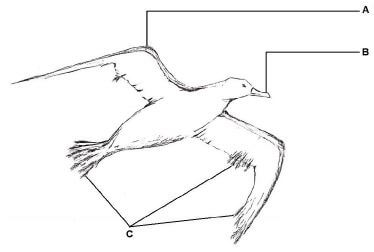
1.4.1 For feather A, give:
- The name (1)
- ONE function (1)
1.4.2 Answer the following questions on feathers:
- Name ONE other type of feather found on birds. (1)
- State ONE function of the feather in your answer to QUESTION 1.4.2(a). (1)
(4)
TOTAL SECTION A: 40
SECTION B
QUESTION 2
2.1 Identify the organisms represented by pictures A, B and C below by giving the common name and the class name for EACH.
(3 x 2) (6)
2.2 The diagram below shows the front end of a hagfish. Study the diagram and answer the questions that follow.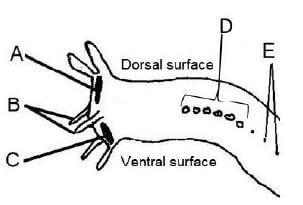
2.2.1 Which letter (AE) indicates the nostril? (1)
2.2.2 What is the adaptation and primary function of structures B? (2)
2.2.3 Label D, which indicates the six large pores. (1)
2.2.4
- Name the smaller pores, indicated by E, that continue all the way to the tail. (1)
- How do the pores assist the hagfish to protect itself? (2)
2.2.5 C indicates the mouth. Explain how the hagfish ingests food. (3)
(10)
2.3 Read the extract about sea squirts below and answer the questions that follow.
One of our closer relatives does not look a lot like us. It is effectively a tough, fluid-filled, translucent bag sitting at the bottom of the sea, spending its time sucking in water and feeding on microscopic particles it finds there. This week's specimen of the week is your cousin … the sea squirt. [Adapted from a blog by Jack Ashby, of the Grant Museum of Zoology] |
2.3.1 The author is quite correct in saying that the tunicates are closely related to 'us', as they are in the same phylum. Which phylum does the author refer to? (1)
2.3.2 Draw a simple outline of a local tunicate, the red bait, to illustrate why the author refers to it as a 'wet paper bag'. Label the siphons. A heading is NOT required. (2)
2.3.3 A closer study of the sea squirt shows only a few characteristics of the phylum that we as humans belong to.
State TWO defining features of the phylum that humans belong to. Also state why scientists have added sea squirts to this phylum. (3)
(6)
2.4
| Sea urchins are stenohaline, meaning that they can only tolerate a limited change in the salinity of their environment. The Breede River in the Western Cape has its mouth at the head of San Sebastian Bay. Sea urchin populations are known to spread closer to the mouth of the river during summer months, only to die off during winter when an increase in rainfall causes the river to flow much more strongly. In the years of the drought, which reached its peak in 2018, sea urchin populations increased in rock pools on both sides of the river mouth until June 2019, when the river flowed strongly for the first time in five years. |
At the end of 2018, a survey was done to determine the effect of salinity on sea urchin population densities in rock pools around six sites.
The map below shows these sites, approximately 500 m apart, from the river mouth to a site just around a point beyond which the river water seldom reached.
MAP OF TEST SITES WHERE AVERAGE SEA URCHIN POPULATION DENSITIES AND SALINITIES WERE RECORDED DURING DECEMBER 2018 AND JULY 2019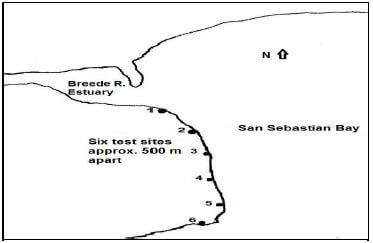
- In 2018, the average population density of sea urchins at all the sites was 10 sea urchins per square metre (m2).
- The salinity was the same at all sites, measuring 35 ppt (parts per thousand).
- Two weeks after the first significant flow of water into the bay, in July 2019, a second survey was done.
- The salinity and average sea urchin population densities were recorded again.
The table below shows the average sea urchin population density and salinity at each of the sites.
| SITE | 1 | 2 | 3 | 4 | 5 | 6 |
| SALINITY (PPT) | 4 | 13 | 18 | 27 | 32 | 35 |
| AVERAGE SEA URCHIN POPULATION DENSITIES (number/m2) | 0 | 1 | 4 | 8 | 10 | 10 |
2.4.1 Draw a chart for the July 2019 data, on the same set of axes, where a bar graph represents the average sea urchin population densities per site and a line graph shows salinities across the sites.
Use the following scale:
- 1 cm per sea urchin for the bar graph
- 1 cm per 5 ppt for the salinity line graph (10)
2.4.2 Write a brief summary of the results indicated on the chart. (3)
2.4.3 Discuss the aspects of sea urchin physiology that make them stenohaline. (3)
2.4.4 Suggest possible reasons why not all the sea urchins die at some of the sites with lower salinities. (2)
(18)
[40]
QUESTION 3
3.1 The extracts below are from a series of blogs written by staff at the Two Oceans Aquarium, Cape Town, about pyjama catsharks and sevengill cowsharks.
Read the extracts below and answer the questions that follow.
PYJAMA CATSHARKS
SEVENGILL COWSHARKS 5. As you may have guessed from its name, the sevengill shark has seven pairs of gills most sharks have only five. They also have only one dorsal fin most sharks have two. 6. They are true apex predators and have even been found to have pups of great white sharks in their stomach contents. [Source: www.aquarium.co.za/blog/sharkshowcase] |
3.1.1 What is the purpose of the barbels mentioned in paragraph 1 AND what evidence in the extract indicates that they would need them? (2)
3.1.2 Explain how catsharks are able to 'roll themselves into a doughnut' (paragraph 2). (2)
3.1.3 Catsharks are nocturnal (paragraph 3). Answer the following questions:
- Which adaptation of their eyes enables them to hunt equally effectively in bright daylight if they sense edible food nearby? (2)
- How does the eye of a bony fish differ from that of a shark? (1)
3.1.4 In paragraph 4 it states that catsharks are oviparous.
- How are they different from bony fish, which are also oviparous, in this reproductive strategy? (1)
- Not all sharks have the same reproductive strategy.
Name TWO other strategies AND explain how the embryos are nourished while they develop. (4)
3.1.5 Refer to paragraph 6.
- What is meant by an apex predator? (1)
- Why has the author used this example to emphasise the statement? (1)
(14)
3.2 Generally, fast-swimming predatory fish, like tuna, have a core of dark muscle around the vertebral column. This muscle is very efficient but needs to be kept warmer than the surroundings in order to function correctly. Viewing the flesh of such a fish under a microscope shows that there is a system of tightly packed capillaries around these core muscles.
3.2.1 Give a name or term for this system. (1)
3.2.2 Explain how this system functions. (3)
(4)
3.3 Consider the diagrams of the shark teeth below and answer the questions that follow.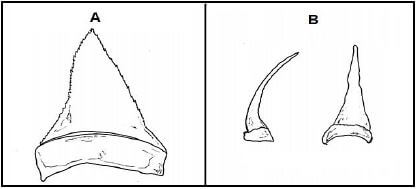
3.3.1 What type of tooth do great white sharks have? (1)
3.3.2 Shark teeth are adapted for functionality.
Analyse the teeth in the diagrams above and describe the structure AND give a specific function for A and B respectively. (4)
(5)
3.4 Reproduction in sharks (elasmobranchs) differ from species to species. View the diagram of an unhatched shark (removed from the egg) below and answer the questions that follow.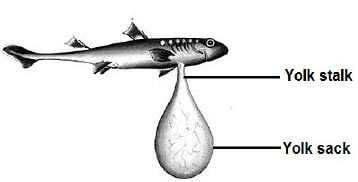
3.4.1
- What is the function of the yolk sack attached to the shark? (1)
- Name the type of reproduction where sharks lay eggs and live young emerge from them. (1)
3.4.2 The blood of sharks travels through the body via single circulation.
What does single circulation mean? (3)
(5)
3.5 Medical doctors have perceived that humans exhibit a physiological response known as the dive reflex. To initiate the dive reflex, a person simply needs to stop breathing (hold their breath) or splash water on the face, submerge the face in water, or place a cold pack across the cheeks and nose. This will cause the person to hold his/her breath automatically and the nervous system will trigger bradycardia.
This reflex assists humans to hold their breath for longer. Gordon Corsetti suggested on his website mentallyagile.com that this technique can be used to control panic attacks which are characterised by an increased breathing rate and a high heart rate and blood pressure brought about by extreme stress. He tested this on himself and noted results within 20 seconds after immersing his face in cold water and even more significantly over the next few minutes. He came up for air occasionally.
As Marine Science students, you will be aware that the dive reflex, better known as diving bradycardia, is a significant characteristic of the other land vertebrate classes, especially those which have returned to marine habitats.
3.5.1 What result would Gordon Corsetti have reported from his experiment? (2)
3.5.2 How would this be useful to someone having a panic attack? (1)
3.5.3 Name THREE changes within the bodies of marine mammals during diving bradycardia. (3)
3.5.4 Turtles are able to stay submerged for significantly longer than mammals or birds of a similar size and mass. Explain why this is the case. (3)
3.5.5 Diving birds and mammals may be able to stay submerged for shorter times than turtles, but they have a different advantage. What is this advantage and why do they have it? (3)
(12)
[40]
TOTAL SECTION B: 80
SECTION C
Answer any ONE question in this section.
Clearly indicate the QUESTION NUMBER of the chosen question.
NOTE:
Your answer must be in the form of an essay. NO marks will be awarded for answers in the form of a table, flow charts or diagrams.
QUESTION 4
| 'Evidence from fossil records shows that vertebrates slowly evolved from fish similar to mudskippers in order to move onto dry land. The gaseous exchange process evolved significantly in vertebrate classes as they slowly populated more demanding land habitats and changed lifestyles.' |
Support this statement by comparing the gaseous exchange process in typical examples of Osteichthyes, Amphibia, Reptilia and Aves.
Content: (25)
Synthesis: (5)
[30]
QUESTION 5
| 'Evidence from fossil records shows that vertebrates slowly evolved from fish similar to mudskippers in order to move onto dry land. The process of reproduction and parental care evolved significantly in vertebrate classes as they slowly populated more demanding land habitats and changed lifestyles.' |
Support this statement by comparing reproduction and parental care in typical examples of Osteichthyes and the four land-living vertebrate classes.
Content: (25)
Synthesis: (5)
[30]
TOTAL SECTION C: 30
GRAND TOTAL: 150